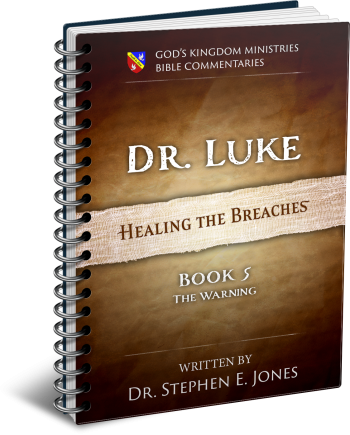Latest Posts
View the latest posts in an easy-to-read list format, with filtering options.

This is a commentary on Luke 12-14, where Jesus gives warning to Jerusalem and how to avoid divine judgment.
Category - Bible Commentaries

The dinner that Jesus attended in Luke 14 became the occasion of much teaching. First, Jesus noticed some who quickly took the best and most honorable seats at the table. This became a lesson in humility (Luke 14:11).
Jesus’ lesson in humility is then followed by a lesson in unconditional love. Luke 14:12-14 says,
12 And He also went to say to the one who had invited Him, “When you give a luncheon or a dinner, do not invite your friends or your brothers or your relatives or rich neighbors, lest they also invite you in return, and repayment come to you. 13 But when you give a reception, invite the poor, the crippled, the lame, the blind, 14 and you will be blessed, since they do not have the means to repay you; for you will be repaid at the resurrection of the righteous.”
Whereas the first lesson on humility was given to those who had taken the honorable seats at the table, this second lesson was spoken to the host himself.
This lesson shows the difference between two kinds of love: phileo and agape. Phileo is brotherly love, and the kind of love most prevalent among siblings is a 50/50 relationship that can best be described as equal justice. Agape, on the other hand, gives with no thought of an equal return.
The law prescribes equal justice for all, which is phileo, but once a sentence has been rendered, the victim has the opportunity and the right to forego his right to receive restitution or compensation for loss. Hence, we see that all men have the right to show agape love, even though the law is limited to phileo. The law is bound to uphold the rights of all men, but grace has the ability to go beyond one’s right.
This is seen in Jesus’ suggestion to his host. If you give to those who will reciprocate, then you are functioning in phileo love, which is good, lawful, and just. But if you give to those who have no way to repay, you make yourself, as it were, a victim of inequality and function in agape love. This is the realm of grace, which goes beyond the equal justice demands found in the law. The law never demands that a victim give grace to the sinner who has victimized him, but it always upholds the victim’s right to forgive.
This is the law of agape love. Jesus called it a “new command-ment,” not because it was new, but because it went beyond the equal justice of the law that they were used to following. So Jesus said in John 13:34,
34 A new commandment I give to you, that you love [agapao] one another, even as I have loved you, that you also love one another.
Jesus’ example, of course, can be seen in His death on the cross, where He set aside His rights and took upon Himself the penalty for all the sin in the world (1 John 2:2). By afflicting Himself with the liability for all sin, He willingly made Himself the victim, which then gave Him the lawful right to give grace and forgiveness to all men. This He expressed on the cross (Luke 23:34), and this is how He could literally forgive every sin of the whole world—and the law would uphold His right to do so. In other words, the justice of the law was satisfied.
Having said that, we also know that every victim has the right to forgive and extend grace in whatever manner he/she deems best. To forgive sin is good, but sometimes men need to be held accountable in order to bring repentance and cause them to learn righteousness. This is why Scripture continues to speak of judgment upon sinners at the Great White Throne. Jesus has the right to forgive, but wisdom dictates that all men should first come to the place of repentance and be trained in righteousness.
And so He has chosen to allow a certain amount of judgment to fall upon those who did not repent during their life time. Isaiah 26:9 prophesies, “when the earth experiences Thy judgments, the inhabitants of the world learn righteousness.” Yet the amount of judgment is limited by the law of Jubilee (Lev. 25:10) and the law of forty stripes (Deut. 25:1-3).
When we understand the divine law, its justice and mercy, and how it upholds the rights of victims, then we can begin to understand divine justice in the judgment of the world. We can see that Jesus became the Victim in order to obtain the right to forgive all men in the end. Yet His right to bring a certain level of judgment is also upheld by the same law. He may forgive fully or in part, according to His wisdom. Hence, the fact that He brings judgment to the world (John 5:26, 27) does not negate His right—or His ability—to be the savior of the world (1 Tim. 4:10).
Hence, whether Jesus forgives all things immediately, or forgives a portion of what is owed, or holds men accountable for sin, all is done out of a heart of agape love. Such love is who He is, for “God is love” (1 John 4:8). This is His motivating passion to be the Savior of all men, whether they are saved apart from judgment or through judgment.
Jesus said in Luke 14:14 that those having unconditional love “will be repaid at the resurrection of the righteous.” This is the first resurrection mentioned in Rev. 20:4-6. It is a resurrection limited to “the righteous,” for we read in verses 5 and 6,
5 The rest of the dead did not come to life until the thousand years were completed. This is the first resurrection. 6 Blessed and holy is the one who has part in the first resurrection; over these the second death has no power, but they will be priests of God and of Christ and will reign with Him for a thousand years.
No unrighteous person will be given “life” in this first resurrection. Therefore, it is a limited resurrection. The general resurrection in Rev. 20:12, which occurs a thousand years later, sees all of the dead raised for judgment at the Great White Throne. In this resurrection, there will be both believers and unbelievers. This is the resurrection that Jesus mentioned in John 5:28, 29, where in one hour both good and evil men are raised. At that time, some will be given immortality and others not.
So we see that the two resurrections are distinguished by Jesus’ words. The first resurrection is mentioned in Luke 14:14, while the second is found in John 5:28, 29. Because the second includes believers, it is apparent that not all believers are raised in the first resurrection. This can only mean that the overcomers will be given “life” in the first resurrection, while the other believers will be given “life” in the second resurrection.
The main difference appears to be that the overcomers will receive no judgment at all, but will receive full forgiveness of sin. Other believers, however, who mistreated others, will be in need of some corrective judgment at the Great White Throne, but “they will be saved yet so as by fire” (1 Cor. 3:15).
The unbelievers, however, will have to experience a greater “fire,” called metaphorically “a river of fire” (Dan. 7:10), which flows toward them from beneath the throne. This river becomes a metaphoric “lake of fire” (Rev. 20:14), picturing the long-term judgment of the “fiery law” (Deut. 33:2, KJV).
Whereas the believers at that time will receive short-term judgment, followed by the reward of immortality, the unbelievers will have to learn righteousness by the judgments of the law until the great Jubilee sets all creation free into the glorious freedom of the children of God (Rom. 8:21).
In Luke 14 Jesus plainly says that those who practice unconditional love will receive their reward “at the resurrection of the righteous.” Hence, agape love is one of the signs of an overcomer, along with humility. As we will see shortly, faith and wisdom are also such characteristics of the overcomers.
Overall, these instructions come in the context of Jesus’ warning to those of Jerusalem, telling them how to avoid divine judgment. We see that this warning applies not only to the physical destruction of Jerusalem in gehenna, but also to the Great White Throne judgment of the world as a whole. The same principles of judgment that apply to Jerusalem also apply to humanity in general, for the law applies equally to all.